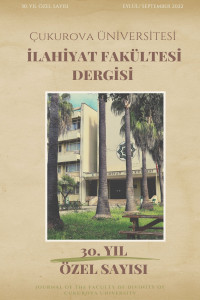“EL-HİZAM” ROMANI ÖRNEĞİNDE OTOBİYOGRAFİ VE KÜLTÜREL KİMLİK
Kültürel kimlik, Otobiyografi, Roman, Suudi Arabistan, el-Hizam
Autobiography and cultural identity
autobiography, cultural identity, Al-hizam, Novel, Saudi Arabia,
___
- Abbas, İhsan, Fennu’s-Sîre, Dâru’ş-Şurûk, Ammân, 1996.
- Câhız, Amr b. Bahr, el-Hayvân, Thk. Abdüsselâm Hârun, 2. Baskı, Mektebetü’l-Bâbi’l-Halebî, Kâhire, 1968.
- Dayf Şevki, et-Tercemetü’ş-Şahsiyye, 4. Baskı, Dâru’l-Ma'ârif, Kâhire, t.y.
- Ebû Dehmân, Ahmed, el-Hizâm, 1. Baskı, Beyrut, Dâru’s-Sâkî, 2001.
- ed-Derğâmî, Zâyed Âdil, es-Sîretü’z-Zâtiyye, Mecelletü Alâmât fi’n-Nakd, No:65-66, 2008.
- el-Uceyli, şehle, en-Nassu’r-Rivâî ve Düvelü’l-Hüviyyetü’s-Sekâfiyye, Mecelletü Alâmât fi’n-Nakd, No:53, 2004.
- Hân, Muhammed, el-Esâtiru’l-Arabiyye Kable’l-İslâm, Matbaatu Lecneti’t-Te’lîf ve’t-Tercüme ve’n-Neşr, Kâhire, 1937.
- May, George, es-Sîretü’z-Zâtiyye, trc. Muhammed el-Kâdî-Abdullah Sûle, Beytü’l-Hikme, Tunus, 1992.
- Philippe Lejuene, es-Sîratü’z-Zâtiyyetü’l-Mîsâk ve’t-Târih’l-Edebî, trc. Ömer Huliy, 1. Baskı, Dâru’l-Beydâ el-Merkezu’s-Sekâfî el-Arabî, y.y., 1994.
- Pierre Bourdieu, el-Unfu’r-Remzî, trc. Nazir Cahil, el-Merkezu’s-Sekâfî’l-Arabî, Beyrut, 1994.
- Usfûr, Câbir, Zamanu’r-Rivâye, el-Hey’etü’l-Mısriyyetü’l-Âmme li’l-Küttâb, Kâhire, 1999.
- Yayın Aralığı: Yılda 2 Sayı
- Başlangıç: 2001
- Yayıncı: Çukurova Üniversitesi
OSMANLI DÖNEMİNDE HALKIN DİN ANLAYIŞININ OLUŞMASINI ETKİLEYEN KAYNAKLAR
BÜYÜ VE TABİATÜSTÜ GÜÇLERE BAŞVURMA NEDENLERİ ÜZERİNE BİR SAHA ARAŞTIRMASI
Saffet KARTOPU, Abdurrahman ÜNALAN
DUYGULAR BAĞLAMINDA DİN DUYGUSU VE DİNÎ DUYGULAR
18. YÜZYIL ADANA KADI SİCİLLERİNE GÖRE ANLAŞMALI BOŞANMA (MUHÂLE‘A)
İbrahim AYDIN, Tarık TANRIBİLİR, Yasin KARAKUŞ
SAHABÎLERİN TÜRKLERİ TANIMALARI VE İLİŞKİLERİ
